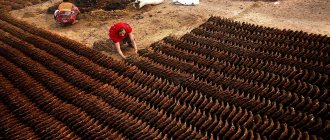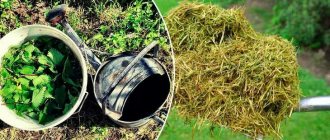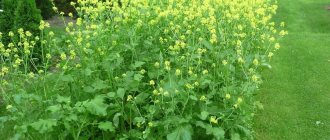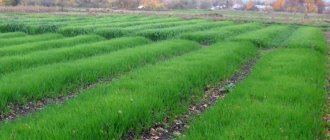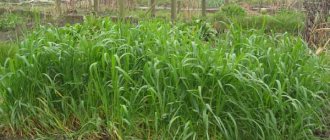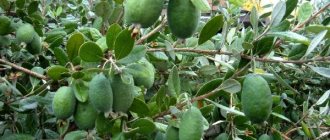Phacelia belongs to herbaceous perennial and annual plants and belongs to the borage family. North and South America are considered its cradle. Today, the plant is distributed throughout the world. The reason for this was a lot of useful and necessary properties, as well as the beautiful appearance of phacelia.
In a short time, phacelia brings back to life the most degraded soil, restoring fertility and balance of substances. The phacelia flower is a honey plant, and the honey obtained from it has unique properties.
The name for the genus comes from the structure of the inflorescence. Phacelia translated from Greek means “bundle”. And on top of everything else, growing phacelia does not require any special knowledge or skills; even a novice gardener can handle it.
What kind of flower is this
The phacelia plant, the photo and description of which are posted in the article, is widely used by modern landscape designers, farmers, beekeepers and flower growers. Its height is 50 -100 cm. The strong stem is located straight, with many lateral shoots, resembling a small bush in appearance. The taproot rhizome grows to a depth of about 25 cm. The shoots are usually covered with pile, have ribbed skin and a bright green color.
Leaves of an ashen and green hue usually germinate oppositely or alternately, and can also be located on shortened petioles. During the growth of the phacelia, the leaf blade takes on a pinnate, dissected or lobed appearance; its edges can be solid or serrated; the relief of the veins can be clearly seen on it.
Advantages and disadvantages
The advantages of phacelia are countless. The disadvantages include the high cost of seeds.
In stores, phacelia is sold for 400 rubles per 0.5 kilogram. If your area is small, this amount will be enough. But if you need a lot of phacelia, then the costs will of course be higher.
The sowing rate for phacelia per hundred square meters is from 150 to 200 grams, depending on how well the soil is prepared.
1000 seeds weigh about 2 g.
A phacelia seed looks like a brown squiggle. They are not visible on the ground, so it is recommended to mix them with sand. They are rough to the touch.
When planting seeds in your garden, they are guided by the approximate weight in a standard plastic cup (200 ml) - 126 grams.
Varieties of phacelia
The genus Phacelia, according to some sources, includes 55-80 species of this plant. In most cases, in our country, twisted, bell-shaped and tansy phacelia are grown. They will be discussed in more detail below:
- Phacelia tansy has a height of about a meter. This is an annual herb that forms a fairly large bush, since up to 20 woolly and fibrous shoots can extend from the main shoot. Around May, pale blue flowers bloom above the leaves, which acquire an oval shape and a jagged edge, collected in a one-sided spike-shaped inflorescence and shaped like a curl. Flowering is accompanied by a sweet aroma of honey.
- Phacelia twisted is distinguished by shoots no more than 50 cm high, which are covered with leaves of green or lighter color with a small pile and a jagged edge. During the period from June to September, very beautiful curls develop on the plants, consisting of bells about 5 mm in size.
- Phacelia bell-shaped has the appearance of erect stems with branches that are about 25 cm high. These are rather fragile but fleshy plants, the surface of which is covered with reddish and slightly fleecy skin. The ovoid-shaped leaves grow alternately and have uneven teeth along the edges. They grow up to 6 cm long and are painted a pleasant green color.
Purple or bluish flowers, which bloom in mid-summer, reach a size of about 3 cm. Large anthers and dark stamens emerge from the white funnel. The inflorescences are collected in curls located in racemes.
Botanical description
The plant Phacelia tansy, or Phacelia Ryazan, is an annual plant more than 1 m high, covered with bristly pubescence. The stem of the plant is erect, with glands, and up to 20 lateral shoots develop on each bush. The basal oblong pinnately dissected leaves reach a length from 6 to 20 and a width from 3 to 15 cm and consist of lanceolate pinnately-toothed leaves. Stem leaves are usually sessile, but may be located on the stem on short petioles.
Beautiful green manure for the garden and flower bed - lupine
Numerous bluish-lilac broadly bell-shaped flowers up to 10 mm long form complex corymbose umbels. The stamens of flowers, up to 14 mm long, protrude strongly from the corolla and consist of bare filaments and oblong elliptical anthers. The fruit of phacelia is a broadly ovoid capsule up to 5 mm long with a pair of dark brown wrinkled seeds.
In the photo: How phacelia blooms in the garden
Phacelia honey plant is a universal green manure: it can be sown both after and before any crop, while after mustard, for example, cruciferous plants cannot be grown on the plot. At the same time, winter-hardy phacelia grows green mass much faster than other green manures and protects the area from weeds. It enriches the soil with potassium and nitrogen and reduces its acidity.
- Planting flowering perennials in open ground
Phacelia flowering
The flowering process of this plant begins in late spring and continues, fortunately for gardeners, until late autumn. It is noteworthy that the flowers open only for a maximum of 2 days. Small buds are included in bunches of 50-100 pieces at the end of the stem. The plant has short peduncles, which can also “sit” on peduncles. The corollas of phacelia have the appearance of a bell, and they are colored, as mentioned above, usually purple or blue. Thin and long stamens with petals that have grown together look out from the central part of the flower.
The phacelia flower (see photo in the article) is pollinated by insects, after which the seed pods begin to ripen with a large amount of small seeds. So, in just 1 gram of sowing material there are about 2,000 seeds.
The flowering of the honey plant will depend on the weather: if it is cloudy and rainy, and also if there is a sharp drop in temperature, this will significantly reduce the release of nectar. Thanks to this characteristic, phacelia plantations located in the south have greater productivity than plants growing in the north.
Use as fertilizer
Phacelia loves the sun, but can withstand slight shading. If the soil is light and drained, there will be maximum yield of green mass.
If the soil is heavy and clayey, then the soil must be prepared: dug up, remove excess grass and weeds. Then sow the phacelia seeds and the useful grass itself will work to restore the soil structure.
Features of vegetation cycles determine its biological value as a fertilizer:
- This useful green manure can be used in any gardens, plots and farms. Do you have a garden with fruit trees, or just berry bushes, or an apiary, or a field with potatoes? Adds organic matter and nitrogen to the soil in a form that is easily digestible for vegetables and trees.
- The full growth period of phacelia lasts approximately 85 days, so it can be planted more than once per season, depending on the latitude.
- It grows at a powerful pace: in 45 days it gains the largest amount of green mass, up to approximately 300 kg per hundred square meters.
- The plant can withstand short-term cold snaps.
- Unaffected by dry conditions.
- Can be used both for open ground and greenhouses.
- Phacelia repels pests. The aroma of the plant is strong and releases special substances - phytoncides, but at the same time attracts beneficial insects. Because of the sweet smell, bees happily circle over the flowers.
- The wireworm is a nasty creature, it makes holes in potatoes and carrots, the holes then turn brown, they need to be cut out. Growing green manure on the plot will help get rid of this scourge of every gardener. Fungal diseases, to which tomatoes and roses are very prone, can also be calmed down with the help of healthy herbs.
- Sowing phacelia on a plot of land helps better pollination of berry and vegetable crops, as it attracts bees. Therefore there will be more ovaries. When the weather is cool and not sunny, which is especially typical for the middle zone and northern regions, people buy the drug “Ovary” or “Tomaton”. This is not a cheap powder with growth hormones.
Plant propagation
The named plant reproduces through seeds. Planting is done in the spring. All seeds should be carefully covered with soil, as they germinate best in the dark. The first seedlings hatch approximately 7-10 days after sowing. After noticeable growth of the seedlings, they must be thinned out, leaving a distance of 10-15 cm between them.
Contraindications
Although phacelia, as a honey plant, is quite good and its honey is considered one of the most useful, this does not mean that it does not have contraindications that must be taken into account before use. Contraindications for consuming honey include:
- diabetes mellitus: despite the fact that phacelia honey is rich in fructose, you still need to limit your carbohydrate intake. The consumption of honey is allowed, but only after consultation with an endocrinologist and in limited quantities; Read also: Celery juice: beneficial properties, contraindications, benefits and harms.
- Individual intolerance: occurs in all types of honey, due to the presence of a huge number of active substances among the product components. If there have previously been cases of an allergic or other adverse reaction to this product, then you should not use it;
- pregnancy, as well as breastfeeding: due to the presence of phytoestrogens in honey, it is advisable to exclude it from the diet for women who are experiencing any hormonal changes.
Features of breeding phacelia
Due to the fairly wide sowing row, plants need regular row-spacing treatment and weed removal. Many gardeners prefer to treat seeds with special herbicides before sowing. But, in fact, this does more harm to the future plant than it benefits. After flowering is over, the plants must be mowed and chopped, and then buried not very deep in the ground.
Phacelia is planted in early spring, when the snow has just melted, and until autumn. But the most fertile time for sowing is June or July. The seeds need to be buried approximately 3 cm.
To plant honey plants, choose an area that will be protected from dry and very strong winds and well lit by the sun. Under such conditions, the amount of pollen and nectar increases significantly and the flowering of plants is prolonged.
Growing phacelia as green manure
When to sow in the ground
Phacelia as a green manure is widely popular among gardeners and gardeners. The timing of its sowing is determined by the goals you are pursuing:
- when sowing a crop immediately after the snow melts, the seedlings that appear two weeks later quickly increase green mass, which allows you to get excellent humus after mowing the grass, provided that the grass is embedded shallowly in the soil or mulch, if the grass remains lying on the surface;
- when using phacelia as a honey plant, it is planted between the rows of other crops throughout the season. In this case, the wilted grass is mowed and used in the future as fertilizer or as mulch, and the next sowing is done in the free areas;
- sowing phacelia after harvesting from late summer to mid-autumn restores and heals the soil, improves its composition and saturates it with nutrients. If you leave mowed grass on the surface of the site as mulch, it will protect the roots of perennial plants from freezing, and the soil from erosion and leaching of useful substances by autumn rains;
- When sown in winter, phacelia produces early shoots in the spring, which are cut off before planting early-ripening varieties of the main crop. In this case, phacelia needs to be sown much thicker, since not all seeds may germinate after a cold winter.
How to sow
Phacelia seeds with good germination do not need preliminary stratification. They are scattered around the site in soil loosened by a rake. Dark phacelia seeds are indistinguishable on the surface of the earth, and in order not to leave unsown areas, it is better to mix them with dry sand before sowing.
If you sow phacelia between the rows of the main crop, make a furrow 2-3 cm deep, spill it with water and, evenly distributing the seeds in it, seal them. In this case, if the weather is not too hot and dry, there is no need to water the furrow after sowing.
Phacelia care
Phacelia needs moisture only at the stage of seed germination, but when sowing in early spring, the soil is well saturated with moisture, and you do not have to water it. In a season with an average amount of rain, natural precipitation is sufficient for phacelia, so the area needs to be moistened only during periods of prolonged drought. Otherwise, caring for growing green manure involves only periodic shallow loosening of the soil.
Radish is also a green manure, but you need to plant it correctly!
Organic fertilizers Optim-Humus, Baikal EM-1, Bokashi, Siyanie-1, containing effective soil microorganisms, will help you obtain a rich harvest of phacelia green mass They must be added in strict accordance with the instructions.
In the photo: Phacelia flowering
Mow green manure phacelia in the bud formation phase. If you delay mowing, the leaves and stems of the plant will have time to harden and will decompose much more slowly, and the longer the decomposition process, the more organisms harmful to the soil and plants develop in the rotting mass. The mown phacelia is dug up with the top layer of soil, having previously been treated with a means that accelerates processing. Decomposition of phacelia and further humification of the soil occurs only in the presence of moisture, therefore, in conditions of lack of precipitation, it is necessary to irrigate the area.
- Tulip bulbs
After incorporating green manure into the soil, the surface is leveled and re-sown with phacelia. Thus, in one season you can grow 3-4 crops of green manure, and next spring you can use this area with updated nutritious soil for growing vegetables.
Pests and diseases
Phacelia not only has high resistance to any pests and infections, but is also able to protect neighboring crops from them. For preventive purposes, phacelia is sown in mixed plantings, alternating its rows with rows of vegetables that do not have such resistance.
Phacelia care
Phacelia is considered a tenacious and picky crop. It is characterized by resistance to drought; watering will only be needed in the event of a prolonged lack of precipitation - if the soil surface cracks. In the initial 2-3 weeks of seedling growth, weeding and loosening of the soil will be required. Then this procedure will no longer be required.
To improve flowering and rapid growth, it is recommended to fertilize the crop twice a season using universal mineral complexes. The buds open a month after sowing.
Seeds begin to be collected after half of the achenes have turned brown. The main thing is not to miss this moment, since the ripened achenes open naturally.
Features of reproduction
Cultivation is carried out immediately in open soil. Young seedlings can withstand sub-zero temperatures (not lower than -9°C). You can sow the plant for the winter; this is done in November (but before the onset of frost). In spring, sowing is allowed from mid-March until the second half of April.
Phacelia can be planted anywhere on your site, the plant takes root well, the main thing is to water it in a timely manner.
In July you can sow the plant a second time. Since the seeds are small, they are used to make a mass based on sand and sawdust. 100 g of seed is enough for a 60-80 m² plot. The distance between seedlings is 4-7 cm.
Beneficial properties for soil and plants
Green manure grasses - phacelia, lupine, clover, alfalfa and others - enrich the soil with nitrogen, which is necessary at the initial stage of growth of garden crops - vegetables, berries, fruit trees. Green manure tissues contain potassium and phosphorus, which are necessary for fruit set and root system growth. In terms of ratio, green fertilizer is superior to manure, since it does not contain phosphorus. It has to be added in the form of mineral salts.
But the most important thing is organic matter, the amount of which in the soil affects its characteristics. If there is little organic matter, the soil is susceptible to water erosion and weathering. The color of the soil changes from rich black to gray. Beneficial bacteria feed on organic matter; if there is little of it, the microorganisms die and the soil becomes even more depleted.
Video: An interesting story about phacelia
When the acidity changes in the soil, lovers of an acidic environment appear - nematodes and wireworms. You can’t expect a good harvest after them. Sick plants develop fungus and bacterial root rot.
All the consequences of depletion of the soil fertile horizon can be cured using the green manure method by planting companion plants as intermediate or independent crops.
The method does not contribute to the accumulation of nitrates and is completely harmless to plants and humans.
